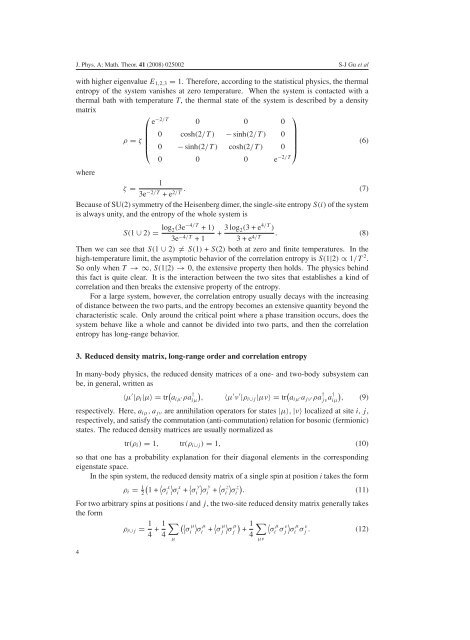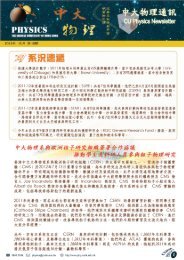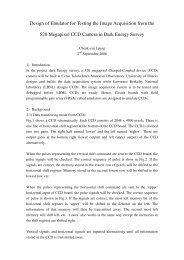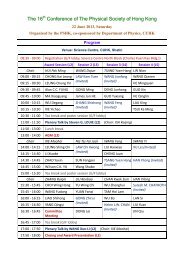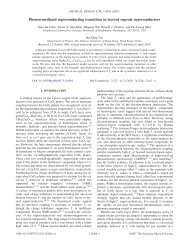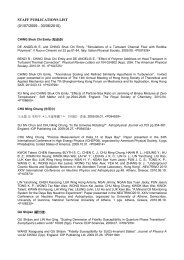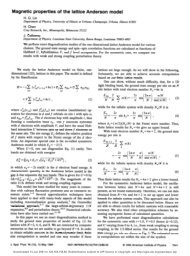Universal role of correlation entropy in critical phenomena
Universal role of correlation entropy in critical phenomena
Universal role of correlation entropy in critical phenomena
Create successful ePaper yourself
Turn your PDF publications into a flip-book with our unique Google optimized e-Paper software.
J. Phys. A: Math. Theor. 41 (2008) 025002 S-J Gu et al<br />
with higher eigenvalue E 1,2,3 = 1. Therefore, accord<strong>in</strong>g to the statistical physics, the thermal<br />
<strong>entropy</strong> <strong>of</strong> the system vanishes at zero temperature. When the system is contacted with a<br />
thermal bath with temperature T, the thermal state <strong>of</strong> the system is described by a density<br />
matrix<br />
⎛<br />
⎞<br />
e −2/T 0 0 0<br />
0 cosh(2/T) − s<strong>in</strong>h(2/T) 0<br />
ρ = ζ<br />
⎜<br />
⎝ 0 − s<strong>in</strong>h(2/T) cosh(2/T) 0<br />
⎟<br />
(6)<br />
⎠<br />
0 0 0 e −2/T<br />
where<br />
1<br />
ζ =<br />
. (7)<br />
3e −2/T +e2/T Because <strong>of</strong> SU(2) symmetry <strong>of</strong> the Heisenberg dimer, the s<strong>in</strong>gle-site <strong>entropy</strong> S(i)<strong>of</strong> the system<br />
is always unity, and the <strong>entropy</strong> <strong>of</strong> the whole system is<br />
S(1 ∪ 2) = log 2 (3e−4/T +1)<br />
+ 3log 2 (3+e4/T )<br />
. (8)<br />
3e −4/T +1 3+e 4/T<br />
Then we can see that S(1 ∪ 2) ≠ S(1) + S(2) both at zero and f<strong>in</strong>ite temperatures. In the<br />
high-temperature limit, the asymptotic behavior <strong>of</strong> the <strong>correlation</strong> <strong>entropy</strong> is S(1|2) ∝ 1/T 2 .<br />
So only when T →∞,S(1|2) → 0, the extensive property then holds. The physics beh<strong>in</strong>d<br />
this fact is quite clear. It is the <strong>in</strong>teraction between the two sites that establishes a k<strong>in</strong>d <strong>of</strong><br />
<strong>correlation</strong> and then breaks the extensive property <strong>of</strong> the <strong>entropy</strong>.<br />
For a large system, however, the <strong>correlation</strong> <strong>entropy</strong> usually decays with the <strong>in</strong>creas<strong>in</strong>g<br />
<strong>of</strong> distance between the two parts, and the <strong>entropy</strong> becomes an extensive quantity beyond the<br />
characteristic scale. Only around the <strong>critical</strong> po<strong>in</strong>t where a phase transition occurs, does the<br />
system behave like a whole and cannot be divided <strong>in</strong>to two parts, and then the <strong>correlation</strong><br />
<strong>entropy</strong> has long-range behavior.<br />
3. Reduced density matrix, long-range order and <strong>correlation</strong> <strong>entropy</strong><br />
In many-body physics, the reduced density matrices <strong>of</strong> a one- and two-body subsystem can<br />
be, <strong>in</strong> general, written as<br />
〈µ ′ |ρ i |µ〉 =tr ( a iµ ′ρa † iµ)<br />
, 〈µ ′ ν ′ |ρ i∪j |µν〉 =tr ( a iµ ′a jν ′ρa † jν a† iµ)<br />
, (9)<br />
respectively. Here, a iµ ,a jν are annihilation operators for states |µ〉, |ν〉 localized at site i, j,<br />
respectively, and satisfy the commutation (anti-commutation) relation for bosonic (fermionic)<br />
states. The reduced density matrices are usually normalized as<br />
tr(ρ i ) = 1, tr(ρ i∪j ) = 1, (10)<br />
so that one has a probability explanation for their diagonal elements <strong>in</strong> the correspond<strong>in</strong>g<br />
eigenstate space.<br />
In the sp<strong>in</strong> system, the reduced density matrix <strong>of</strong> a s<strong>in</strong>gle sp<strong>in</strong> at position i takes the form<br />
( 〈 〉<br />
ρ i = 1 2 1+ σ<br />
x<br />
i σ<br />
x<br />
i + 〈 σ y 〉<br />
y<br />
i σ<br />
i<br />
+ 〈 σ z 〉 )<br />
i σ<br />
z<br />
i . (11)<br />
For two arbitrary sp<strong>in</strong>s at positions i and j, the two-site reduced density matrix generally takes<br />
the form<br />
ρ i∪j = 1 4 + 1 ∑ (〈<br />
µ<br />
〉<br />
µ σ<br />
i σ<br />
i<br />
+ 〈 σ µ 〉<br />
µ<br />
) 1 ∑ 〈<br />
µ<br />
j σ<br />
j + σ<br />
i<br />
σ ν 〉<br />
µ<br />
j σ<br />
i<br />
σj ν 4<br />
4<br />
. (12)<br />
4<br />
µ<br />
µν


